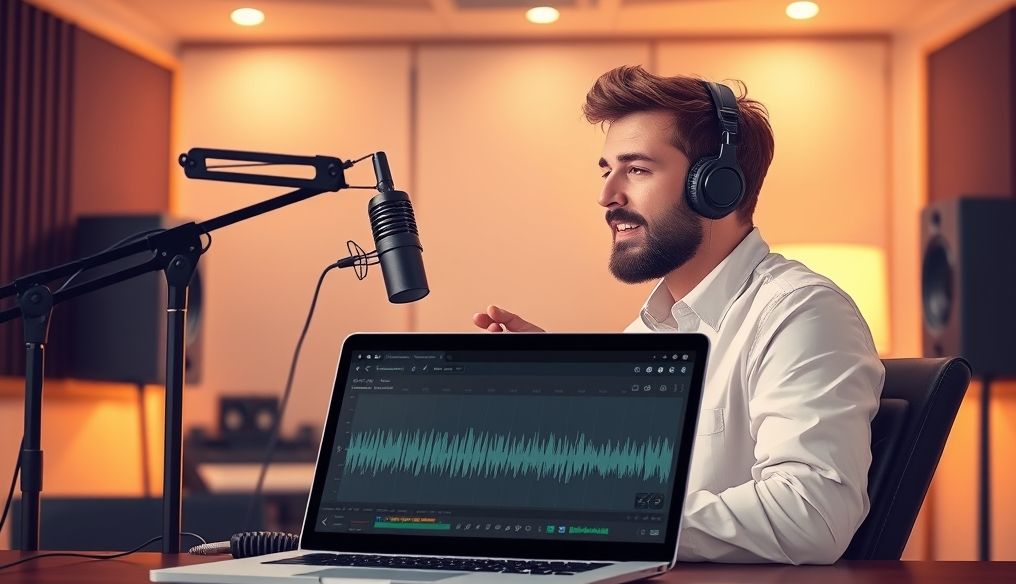Introduction: The Age of Audio Content and Available Opportunities
The media landscape is undergoing a radical shift towards audio content, driven by its ease of access and diversity. Podcasts, audiobooks, audio courses, and spoken articles are all forms that are growing in popularity day by day. This growth creates tremendous opportunities for creators and aspiring entrepreneurs to profit from the production and sale of audio content.
Chapter 1: Identifying Your Target Audience and Understanding Their Needs
The first step towards success in the world of audio content is to accurately identify your target audience. Who are the people you want to reach? What are their interests? What problems do they face and seek solutions for?
- Demographic Analysis: Age, gender, geographic location, education, income.
- Psychographic Analysis: Values, interests, lifestyle, motivations.
- Behavioral Analysis: Listening habits, preferred content types, platforms used.
Once you understand your target audience, you can design content that meets their needs and provides them with real value. For example, if your target audience is young entrepreneurs, you can produce a podcast discussing successful digital marketing strategies or interviews with inspiring entrepreneurs.
Chapter 2: Choosing the Right Niche and Defining the Type of Content
After identifying your target audience, it's time to choose the right niche. What topics are you passionate about and have expertise in? What areas are experiencing increasing demand for audio content?
Examples of Popular Niches:
- Finance and Investment: Investment tips, financial market analysis, interviews with experts.
- Personal Development: Leadership skills, time management, overcoming stress.
- Health and Wellness: Healthy eating, exercise, mental health.
- Technology: Latest news, product reviews, usage tips.
- History and Culture: Historical stories, cultural analyses, interviews with historians.
Types of Audio Content:
- Podcasts: Regular episodes covering various topics.
- Audiobooks: Audio recording of books.
- Audio Courses: Educational lessons in audio format.
- Spoken Articles: Converting written articles into audio.
Chapter 3: Tools and Equipment for Audio Content Production
To produce high-quality audio content, you need some essential tools and equipment:
- Microphone: Choose a professional microphone to record clear and crisp audio.
- Headphones: Use headphones to monitor the sound during recording.
- Audio Editing Software: Use audio editing software to remove noise and improve sound quality. (Audacity, Adobe Audition)
- Audio Interface: To improve the quality of the input from the microphone to the computer.
Investing in good equipment will help you produce professional audio content that attracts listeners.
Chapter 4: Steps to Produce a Successful Podcast
Producing a successful podcast requires careful planning and meticulous execution:
- Planning Episodes: Determine episode topics in advance and prepare key points.
- Recording: Record your voice in a quiet, noise-free environment.
- Editing: Edit the audio to remove errors and improve quality.
- Music and Sound Effects: Add music and sound effects to create a sense of suspense and excitement.
- Publishing: Publish podcast episodes on various podcast platforms (Spotify, Apple Podcasts, Google Podcasts).
Additional Tips:
- Be Consistent: Publish new episodes regularly to keep listeners interested.
- Interact with Listeners: Respond to listener comments and questions.
- Host Guests: Host guests to add variety to the podcast and attract a new audience.
Chapter 5: Effective Marketing Strategies for Audio Content
Marketing is key to reaching a wider audience and increasing the number of listeners. Use these strategies to promote your audio content:
- Social Media: Share podcast episodes and audio clips on social media.
- Email Marketing: Build an email list to send newsletters to listeners.
- Collaborate with Bloggers and Influencers: Collaborate with bloggers and influencers in your niche to promote your content.
- Paid Advertising: Use paid advertising on podcast platforms and social media to reach a wider audience.
- Search Engine Optimization (SEO): Use relevant keywords in episode titles and descriptions to improve their visibility in search results.
Chapter 6: Ways to Monetize Audio Content
There are many ways to monetize audio content:
- Advertising: Display ads in podcast episodes or audio clips.
- Sponsorship: Get sponsorship from companies in exchange for promoting their products or services.
- Paid Memberships: Offer exclusive content to listeners who pay a membership fee.
- Selling Products and Services: Sell products and services related to the podcast content or audio courses.
- Donations: Request donations from listeners who appreciate your content.
Chapter 7: Building a Strong Personal Brand
Building a strong personal brand helps you stand out from the competition and attract listeners and customers. Focus on these elements:
- Name and Logo: Choose a distinctive name and logo that reflect your brand identity.
- Website: Create a website to showcase your content and connect with listeners.
- Social Media: Use social media to interact with listeners and share your content.
- Personal Story: Share your personal story with listeners to build trust.
Chapter 8: Analyzing Performance and Improving Content
Analyze the performance of your audio content regularly to identify strengths and weaknesses. Use these metrics:
- Downloads and Listens: Track the number of podcast episodes downloaded or listened to.
- Ratings and Reviews: Monitor ratings and reviews on podcast platforms.
- Content Sharing: Track the number of times content is shared on social media.
- Conversion Rate: Track the number of listeners who convert into customers.
Use this data to improve your content and better meet the needs of listeners.
Chapter 9: Common Mistakes to Avoid
Avoid these common mistakes to increase your chances of success in the world of audio content:
- Lack of Pre-Planning: Plan episodes in advance and identify key points.
- Poor Sound Quality: Use good equipment and edit the audio to improve quality.
- Inconsistency: Publish new episodes regularly to keep listeners interested.
- Failure to Promote Content: Use various marketing strategies to promote your content.
- Lack of Interaction with Listeners: Respond to listener comments and questions.
Chapter 10: The Future of Audio Content and New Trends
The world of audio content is constantly evolving. Stay up-to-date with new trends:
- Artificial Intelligence: Using artificial intelligence in the production and editing of audio content.
- Interactive Audio Content: Adding interactive elements to audio content to increase engagement with listeners.
- Augmented Reality: Integrating audio content with augmented reality to provide immersive experiences.
By embracing these new trends, you can stay ahead of the curve and achieve success in the world of audio content.
Example from the Arab Market: "Thamanya" podcast, which offers diverse content in various fields and generates revenue from advertising and sponsorship.
Global Example: "The Joe Rogan Experience" podcast, which generates huge profits through an exclusive agreement with Spotify and advertising.




